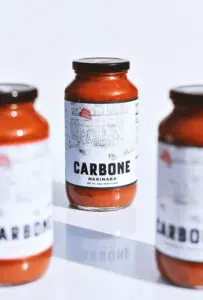As the story goes, the seeds for LeBron James’s HBO show, The Shop, were planted one evening in late 2015 in New York, when James and his business partner Maverick Carter, the advertising executive Steve Stoute, Paul Rivera (who works for James and Carter), and the rapper Nas were having dinner at Carbone, one of the NBA star’s favorite spots. Drake has also dropped a reference to the high-end, over-the-top reinvention of Italian red-sauce joints in his 2017 track “Do Not Disturb.”

This week, Mario Carbone, Rich Torrisi, and Jeff Zalaznick—the chefs and cofounders of the New York-based Major Food Group (MFG)—are expanding into consumer packaged goods with a line of three Carbone-branded pasta sauces. They quietly hit shelves at the regional grocery Stop & Shop around New York, New Jersey, and Connecticut but are now launching nationally via direct-to-consumer sales and on Amazon.
In 2013, Carbone joined with cofounders to open his eponymous restaurant, which has since become renowned for its retro chic and its clever tweaks on baked clams, tableside Caesar salad, and rigatoni. He says this is something they’ve been thinking about for a long time.
“When you have these restaurants, and we’ve been lucky and quite blessed that they’ve been as popular as they have, but it’s still a pretty finite number of people a night,” says Carbone. “It’s wonderful to operate in multiple cities now, but the opportunity that presents itself is, now that we’ve built this brand, through consumer packaged goods we can actually touch an immense amount of people that we never would’ve been able to.”
Carbone is a luxury—the prices are as legendary as its service—and MFG has been called a “red sauce juggernaut” for its ability to create food and experiences of the highest caliber. So how do you translate an over-the-top experience into a bottle?
For chef Carbone, that answer lies in the approach. “If you put similar care and thought into the product going on the shelf, as we do in the restaurants, and try to make the absolute best in class, if someone buys our product, then they’ll know it,” he says. “That creates the next exciting opportunity.”
Their move comes at an opportune time. The consumer-packaged-goods pasta sauce market, as with many other CPG categories, is seeing its most growth at the top and bottom of the price spectrum. MFG is naturally targeting what Carbone Fine Foods CEO Eric Skae calls the “super-premium” market. “We’re a super-premium product, and there is opportunity in the category,” says Skae. “There’s one major player, and then a lot of other players. There’s an opportunity for someone to grow alongside that major player, because the super-premium category just continues to develop in pasta sauce.”
That one major player is Rao’s, a brand of consumer pasta sauce originally launched in 1992 as a brand extension of . . . wait for it . . . an exclusive New York City restaurant, established in 1896. Rao’s Specialty Foods was acquired by Sovos Brands in 2017 and has dominated the higher end of the pasta sauce shelf. Does this trajectory sound familiar?
Boston Consulting Group’s global head of the consumer products sector Dan Wald says that in general, throughout CPG categories, people are more selectively picking the categories that they care about, investing more in those products, and saving in others. More often than not, the categories they’re choosing to spend more in are those with clear flavor and quality differences. The ones that skew more mustard than ketchup. “In categories like salsa, salad dressing, or pasta sauce, where you can really differentiate technical benefits and flavor profiles within a category, you do see a stronger high-end market,”says Wald.
The other Rao’s twist is that Skae, who has a long and storied CPG career with brands such as AriZona iced tea and Iceland Springs, is also a former CEO of Rao’s, so he knows exactly what Carbone is up against. “We have incredible teams at our restaurants, and Eric is a testament to that commitment,” says Zalanick, who says that the goal was for the quality of the jarred sauce to meet that of the restaurants. “He’s the missing piece, the most seasoned all-star in this space. We knew he’d be an incredible partner to run this business with us and really take it to the level we’ve taken the restaurants to.”
Restaurants and celebrities translating their brand equity to the CPG space isn’t new, but the bulk of those have been through licensing deals where a manufacturer and distributor acquires the rights to the big name. Here, in order to make sure the quality level of the restaurants makes it to shelves or e-commerce orders, MFG has started this as a true extension under the Carbone Fine Foods name.
“With [the licensing model], you lose control of quality, and all the different things that are so important to the identity of a brand like Carbone,” says Zalaznick. “That’s why we chose to do it this way. This is a real company.”
The process behind the sauces is key. The jarred stuff is still slow-cooked for hours over open kettles, with individually opened tin cans of tomatoes from southern Italy, olive oil, onions, and garlic, as well as hand-stripped basil.
“Even tougher than the basil is the fresh oregano,” says Carbone. “We insist on picking fresh oregano, and if you’ve ever seen an oregano leaf, it’s really small. When I first mentioned this in the factory, I didn’t exactly get a standing ovation. But we do it. It takes time and it’s tedious, but we believe it’s worth it.”
Recognize your brand’s excellence by applying to this year’s Brands That Matter Awards before the early-rate deadline, May 3.
